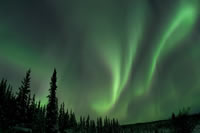Common menu bar links
Natural Elements
The Fascinating Mysteries of the Aurora Borealis
 The Northern lights in all of their splendour.
The Northern lights in all of their splendour.The northern lights have always fascinated people. Beautiful and mysterious, the waves of light seem to emanate from the heavens. Constantly moving, they come in red, purple, green, blue and many other colours. On the latitude where the great scientist Galileo Galilei lived, the northern lights were mostly red, which caused him to name them aurora borealis, Latin for “dawn of the North.”
As mysterious as they are beautiful, we are a long way from understanding exactly what causes them. And as is always the case with things we do not understand, we strive to understand.
What we do know is this. Eruptions and flares on the surface of the sun create clouds of plasma (a gas of electrons and positive ions), which are then thrown into space. Travelling at speeds of 500 or more kilometres per second, these clouds take two to three days to reach Earth.
When they arrive, the solar particles they carry are deflected around the magnetic field that acts as a shield around the Earth. As the particles are deflected, they flow along the magnetic field and create a tail coming off the other side of the earth. Some particles get caught in the tail and are pulled inside the magnetic field.
“The magnetic field holds the plasma in place,” says David Boteler, a scientist with Natural Resources Canada's (NRCan) Geomagnetic Laboratory.
 The solar wind has an average speed of 400 km per second, streaming around Earth like water around a rock. Click to enlarge.
(Image: Dr. Mikko Syrjäsuo)
The solar wind has an average speed of 400 km per second, streaming around Earth like water around a rock. Click to enlarge.
(Image: Dr. Mikko Syrjäsuo)
What happens next?
“We’re not entirely sure,” says David. “At some point, the magnetic field’s control gives way, and the plasma is accelerated towards the earth.”
The particles collide with the atmospheric gases, and the resulting energy is emitted as photons, or light particles, which create the awe-inspiring light show that is the aurora borealis.
This energy, however, also has an unwanted effect — it disturbs the magnetic field, which could disrupt satellites and radio communications, and even trigger blackouts. On March 13, 1989, a magnetic storm caused a blackout of the entire Hydro-Québec system and nearly shut down neighbouring U.S. systems.
The University of Calgary and NRCan’s Geomagnetic Laboratory are working with U.S. National Aeronautics and Space Administration (NASA) to map out exactly how these substorms are created. The project is known as Time History of Events and Macroscale Interactions during Substorms (THEMIS) and will continue for two years.
Five satellites launched by NASA circle the Earth and monitor the buildup of energy. Every four days, they line up over Canada and measure changes in the particles and the magnetic field in space. Cameras are also posted throughout northern Canada to capture the aurora’s activity.The University of Calgary provides ground-based observational equipment, while NRCan supplies NASA and the University of Calgary with data from its geomagnetic observatories across Canada. NRCan also hosts two of the auroral cameras, one at Sanikiluaq on Belcher Islands in Hudson Bay and the other at Meanook, north of Edmonton.
You can see the real-time data at the University of Calgary’s website. As for the aurora, well, you’ll have to wait until nighttime to view its full beauty for yourself.

